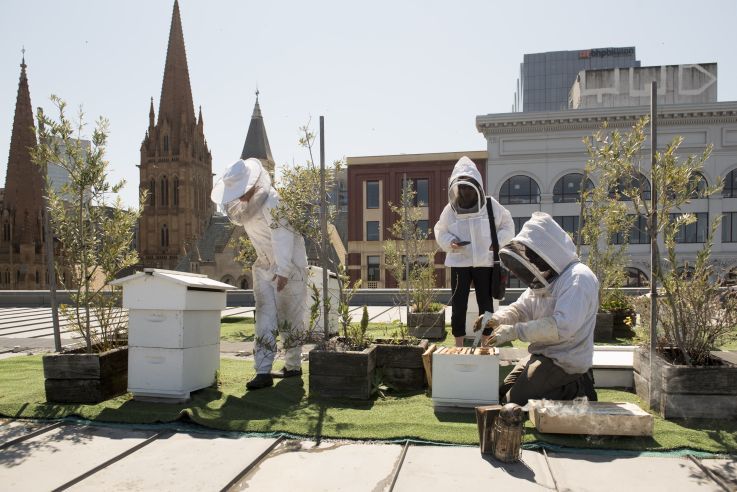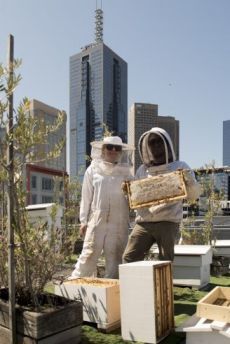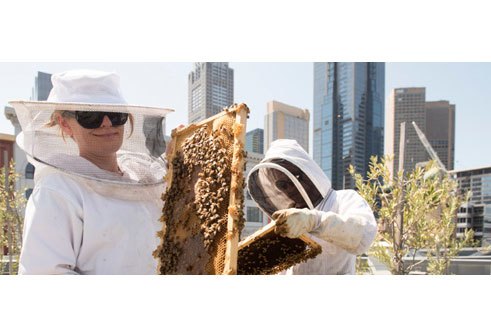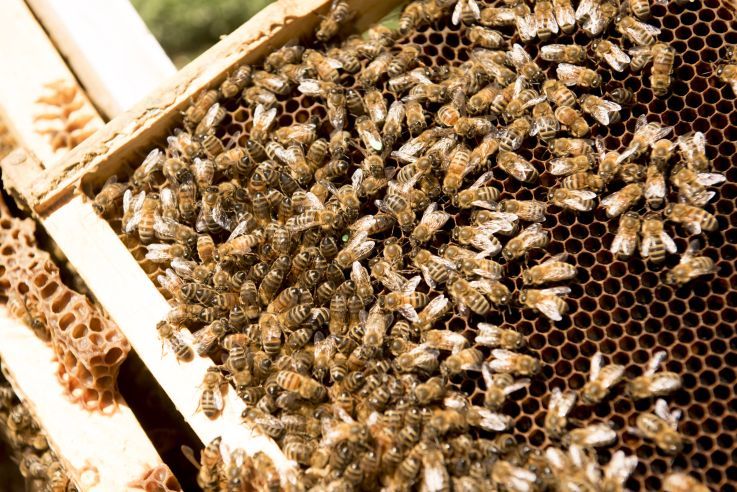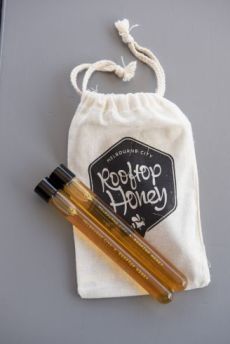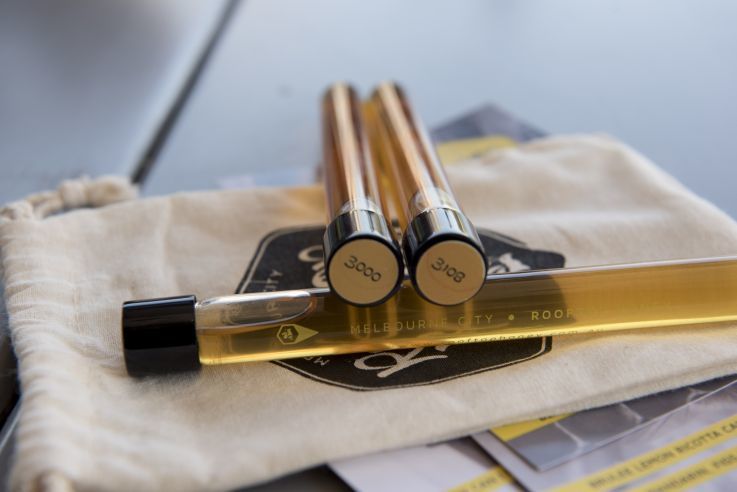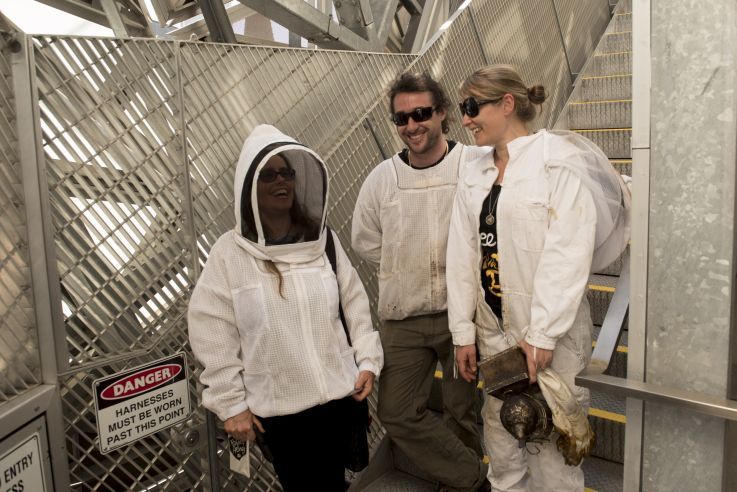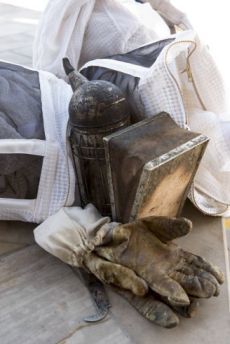Future Perfect
High, not mitey!
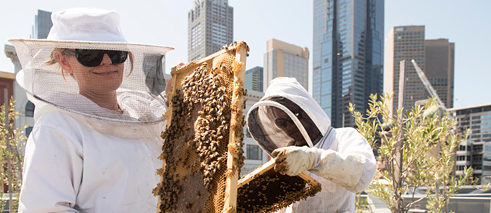
It’s far from a dog’s life for bees living on rooftops in Melbourne, Australia, free from the Varroa mite that has afflicted the rest of the world.
“Welcome to the roof!” We arrive puffing after climbing to the top of the Alfred Deakin Building in iconic Federation Square in the very heart of Melbourne, Australia’s second largest city. “We’re so unfit at the beginning of season, and then you do a few of these rooftop climbs every couple of weeks.”
Beekeeper Vanessa Kwiatkowski looks as if she’s stepped out of a science-fiction movie, dressed in what looks like a white spacesuit with a mesh-fronted helmet. Before us are ten hives on artificial grass, with pot plants to help keep the area cool – and most importantly to provide pollen for the hundreds of thousands of resident bees.
Bee like a dog
“If you’re pretty relaxed, then they are,” Vanessa reassures us. “Bees smell fear like dogs.” It’s the first of several bee-dog analogies we will hear on our visit to the inner-city rooftop hives, some of 80 tended by Vanessa and her partner Mat Lumalasi. But more on that shortly. It’s time to open the hives.With Australian paperbark in the smoker, Mat wafts smoke over the hive to be inspected. It smells like the bushfires that are all too common in Australian summers. Contrary to popular belief, Vanessa thinks that smoke doesn’t actually calm the bees, but sends the bees into an “emergency drill”. They are then too preoccupied to worry about stinging the beekeepers. And it appears to be working. These bees seem pretty docile. “Bees generally are like this,” says Mat. “They are not big, angry, aggressive swarms like we see in the movies.”
“Humans have been selectively breeding bees for traits for hundreds of years and unfortunately we’ve selected for a lot of docility in bees, which is great for us beekeepers, but it hasn’t made them particularly resistant to disease,” Vanessa tells us. “They become like Labradors. Nothing against Labs…” Mat finishes the thought: “…But they’ve become a little too docile.”
From IT buzzwords to … buzz!
Former IT workers Vanessa and Mat started Melbourne City Rooftop Honey five years ago, concerned about the decline of bees around the world. Australia’s top science body says that honey bees are essential for the pollination of about one third of the food we eat, including fruit, vegetables, oils, seeds and nuts. Vanessa and Mat worried that the vital role of pollination was not being recognised or valued, and they were concerned about the risk to the food supply. So concerned that they took the dramatic step of quitting their jobs to become full-time beekeepers.It was Vanessa’s idea to place hives on the roofs of cafés, restaurants and hotels; to bring sustainable honey production – and bees – back to the city. Suburban bees generally produce more than bees in rural areas, due to the proliferation of flowers in the urban areas. The pair felt it was vital to include honey bees in our cities and urban landscapes, and they wanted to educate others about bees and their role. Putting hives on unused rooftops and balconies would also cut food miles, with the honey produced just metres from the food outlet.
When she googled her idea, Vanessa found that cities in Europe had been doing this exact thing for a very long time. But there is one very important difference between rooftop honey in Australia and in other countries around the world. And that difference is the Varroa mite.
Look at our brood, dude!
Mat gently pulls one of the wooden frames out of the rooftop hive. He’s excited about the size and strength of the brood pattern, which shows where the queen has laid her eggs – in effect a bee nursery. “You don’t see strong brood patterns like this in Europe anymore,” Vanessa tells us.The Varroa mite has been attacking bee colonies since the 1960s, slowly spreading from Japan and the then-USSR to all other countries - except Australia. It sucks the "blood" or hemolymph of adult bees, making the bees more prone to infections, and often leading to the collapse of the colony. The export of healthy bees is now a growing industry in Australia. But how long might this last? “So Varroa mite is in New Zealand, it’s in the Solomon Islands, it’s in New Guinea, it’s all around us, and they do believe it’s a matter of when and not if,” says Mat. But he says Australia’s quarantine services are doing a fantastic job.
Mat would still like to see other measures explored. “Find an island off Australia that’s 20 kilometres off shore and start up a bee sanctuary and start breeding them up. They have the international seed vault in Scandinavia,” he argues. A wide variety of plant seeds are stored on a remote Norwegian island to ensure that crop diversity will not be lost in the face of natural or man-made disasters. A blueprint for bee survival?
Worker bees vs. working dogs
And the march of the Varroa mite has led to a rethink of bee breeding techniques. “Instead of docility, they are looking more for hygienic, clean bees, that remove parasites and dead larvae from cells before putting the cap on,” says Mat. So it’s goodbye Labrador, hello Australian Cattle Dog. “A working cattle dog looks after itself pretty much. They don’t get a lot of love and they just work all day,” Mat says.And there is a lot to do if you are a worker bee: Nursing, guard duties, foraging, funeral duties, cleaning… the list goes on. And it’s not just work in the hives. Apart from the vital crop pollination role, bees have been trained to sniff out land mines just like – you guessed it – dogs!
Thousands of pets
Vanessa and Mat are passionate about the weekend hobby that has taken over their lives. Their plan was to provide bees and their hives for free by raising funds and asking local businesses to sponsor hives. The response has been so overwhelming that they are now considering employing staff so the project can continue to grow.Restaurants can host a hive on site and have it fully maintained by Rooftop Honey. The sponsoring restaurant gets up to 20 percent of the honey share, or 6 kilograms, whichever comes first. For an annual maintenance fee of 500 Australian dollars, Melbournians can sponsor a hive of 40,000-50,000 bees, producing on average 30 to 50 kilograms of honey each year. Most commercial hives would expect 100 to 150 kilograms from a similar-sized hive, extracting the honey and feeding sugar syrup back to the bees. Mat and Vanessa don’t feed their bees, leaving two fifths of each hive so the bees can eat their own honey. “If we were to take more and the weather was to turn bad, they could go backwards quite quickly,” Mat says.
So apart from a portion of the honey from the hive, Rooftop Honey sponsors get a sense of community through participating in a sustainable enterprise, an opportunity to learn about and participate in beekeeping, and a different type of pet. But unlike a dog, they can’t pat them!



